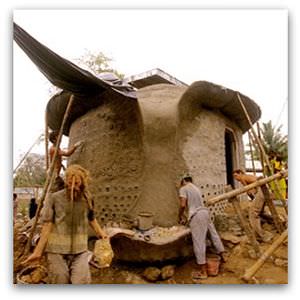Tuesday, November 24, 2009
Crafty Art With A Purpose
Food Not Bomb

http://www.foodnotbombs.net/story.html
REcycled Art of Jen Grant


Artist Statement:
"SWING was created from discarded items of clothing collected from the back alleys and bin areas of tenements in Glasgow. The clothes were then laundered and dried, cut into strips, and woven together to fashion ropes, to which parts of chairs (also found on the streets) were attached to form swings. These were hung from the guardrails on the Botanic Gardens Bridge that crosses the river Kelvin and forms part of the busy Kelvin Walkway.
The clothes that were collected and used for this project were imbued with a personality and invoked very powerfully notions of the abject, each piece telling a story of sorts, albeit ambiguously, about its previous owners and their lives and experiences. The cutting and braiding together of these items seemed almost like weaving together small fragments of narratives from the lives of a myriad of unknown people, creating an object that at once juxtaposes these fragments while creating a new narrative of its own."
Ephemeral Art : Sand Mandala


http://www.artbabble.org/video/creation-sand-mandala
Lama Karma Tenzin created a sand mandala in the theater gallery of the Rubin Museum of Art in NYC. The mandala took over two weeks to create out of millions of grains of crushed marble and under two minutes to destroy. Lama Karma visited the Rubin Museum of Art in conjunction with The Dragon's Gift - The Sacred Arts of Bhutan exhibition.
This video struck me because it reminded me of topics discussed early in the year. I think Lexie did a sand mandala. This is a great video because the mandala is well executed, but also the removal is just as artfully done and respectful as the addition process.
Tuesday, November 17, 2009
Tree Hugger Blog

New Cardbaord ARt
Robert Rauschenberg: Cardbird...Recycled Art


Thursday, November 12, 2009
Lecture November 12th with Avery Kolers
Garbage Warrior
Earthship n. 1. passive solar home made of natural and recycled materials 2. thermal mass construction for temperature stabilization. 3. renewable energy & integrated water systems make the Earthship an off-grid home with little to no utility bills.
Biotecture n. 1. the profession of designing buildings and environments with consideration for their sustainability. 2. A combination of biology and architecture.
For 30 years New Mexico-based Reynolds and his green disciples have devoted their time to advancing the art of "Earthship Biotecture" by building self-sufficient, off-the-grid communities where design and function converge in eco-harmony. However, these experimental structures that defy state standards create conflict between Reynolds and the authorities, who are backed by big business. Frustrated by antiquated legislation, Reynolds lobbies for the right to create a sustainable living test site. While politicians hum and ha, Mother Nature strikes, leaving communities devastated by tsunamis and hurricanes. Reynolds and his crew seize the opportunity to lend their pioneering skills to those who need it most. Shot over three years and in four countries, Garbage Warrior is a timely portrait of a determined visionary, a hero of the 21st century.
Click on the link to watch trailer for movie. Learn more about the film.
http://www.garbagewarrior.com/index.php

Water Crisis

Unfortunately, humans have proved to be inefficient water users. (The average hamburger takes 2,400 liters, or 630 gallons, of water to produce, and many water-intensive crops, such as cotton, are grown in arid regions.)
According to the United Nations, water use has grown at more than twice the rate of population increase in the last century. By 2025, an estimated 1.8 billion people will live in areas plagued by water scarcity, with two-thirds of the world's population living in water-stressed regions as a result of use, growth, and climate change.
(information found on site)
EPA Ready to Dole Out 'Environmental Justice" Grant for Budding Activists.

http://www.cnsnews.com/news/article/56934
CNSNews.com) - The U.S. Environmental Protection Agency is accepting grant applications for projects aimed at addressing environmental and public health issues in “communities with environmental justice concerns.”
The EPA said it expects to award approximately 40 grants of up to $25,000 each in Fiscal 2010. It will accept applications until January 8, 2010.
Local governments and non-profit organizations are eligible to apply. (Ineligible institutions include hospitals, colleges and universities, state governments, quasi-governmental entities, nonprofits that engage in lobbying, and national, multi-state, or statewide organizations with chapters.)
Mountain Justice Website


Tuesday, November 3, 2009
Tire Art buddha
Trip to Bernheim Forest





I took a trip to Bernheim Forest last weekend.
PIctures of the Alter KMAC Native Americans of the Ohio Valley Region: story of the Beaver Clan Family
Great Blog spot


http://atangledbank.blogspot.com









